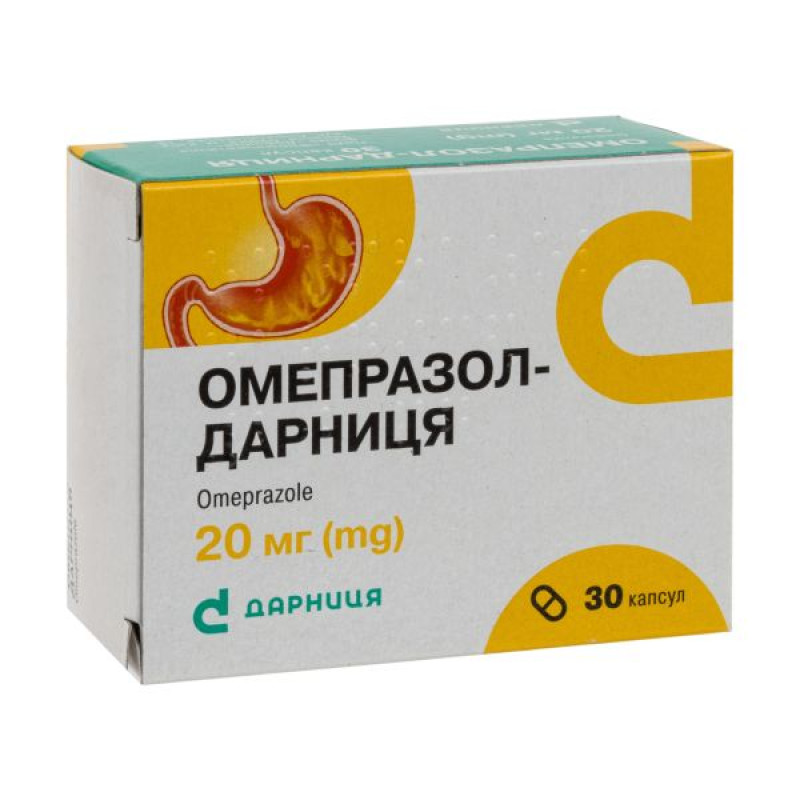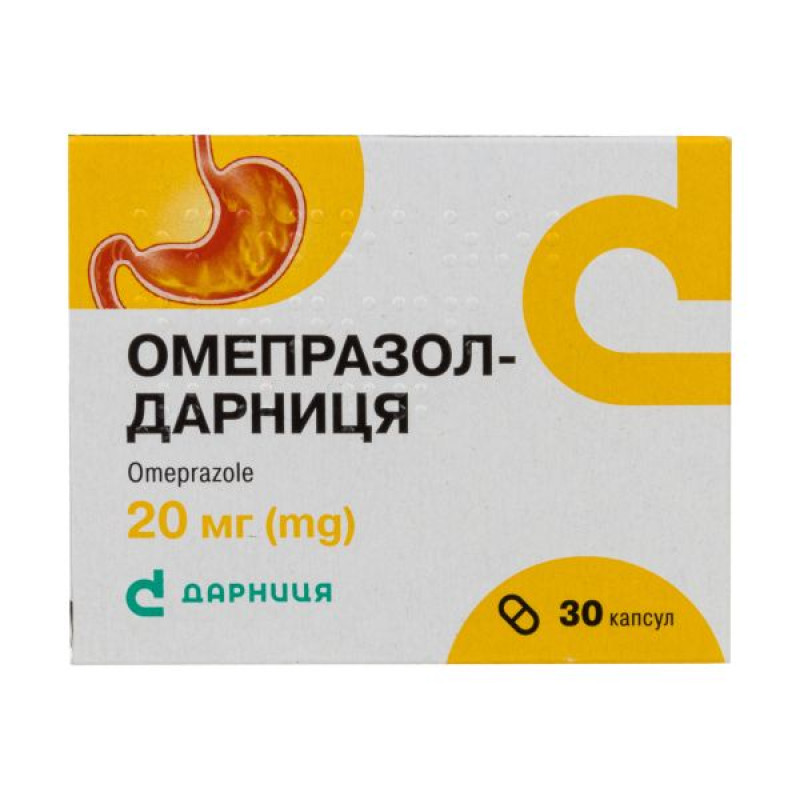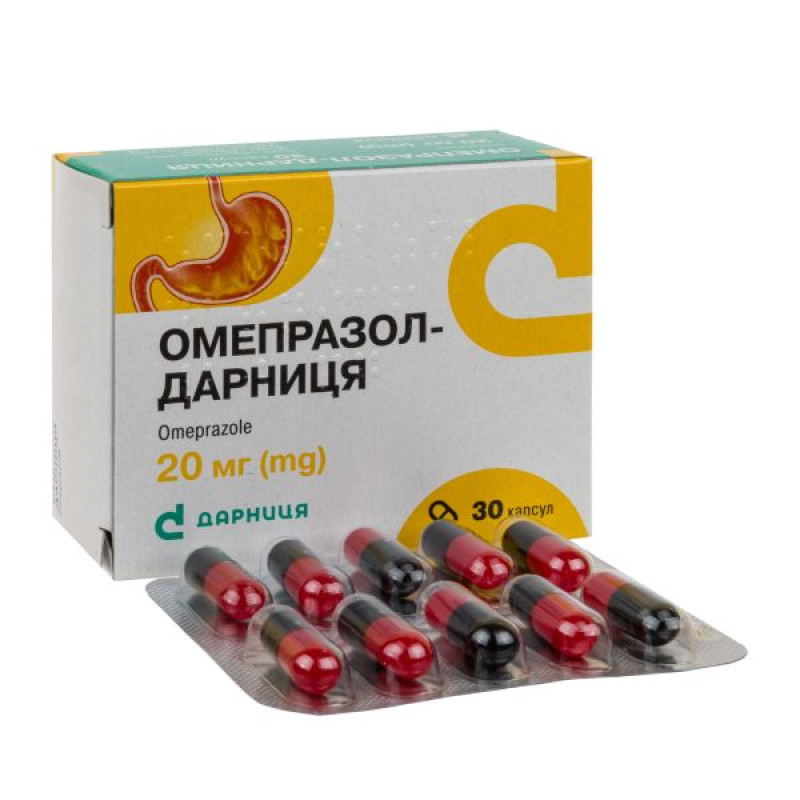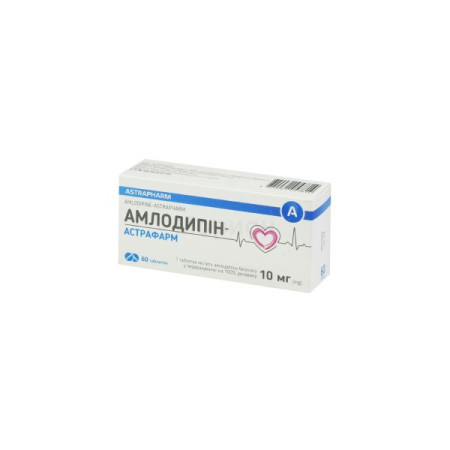Omeprazole-Darnitsa capsules 0.02 No. 30

Instructions for use Omeprazole-Darnitsa capsules 0.02 No. 30
Composition
active substance: omeprazole;
1 capsule contains omeprazole pellets (in terms of omeprazole) 20 mg;
auxiliary substances: mannitol (E 421), hypromellose, methacrylate copolymer dispersion, sodium lauryl sulfate, sodium hydrogen phosphate anhydrous, diethyl phthalate, sucrose, titanium dioxide (E 171), povidone, calcium carbonate, talc, polysorbate-80, sodium hydroxide.
Medicinal form
Capsules. Capsules contain pellets.
The main physical and chemical properties: hard gelatin capsules with a dark red opaque body and an opaque cap of dark gray or black color, containing spherical granules from white to white with a creamy-pink shade of color.
Pharmacotherapeutic group
Means for the treatment of peptic ulcer and gastroesophageal reflux disease. Proton pump inhibitors. Code ATX A02B C01.
Pharmacological properties
Pharmacodynamics.
Omeprazole is an antiulcer antisecretory drug. It easily penetrates into the parietal cells of the mucous membrane of the stomach, concentrates in them and is activated at an acidic pH value. The active metabolite - sulfenamide - suppresses H+, K+-ATPase of the secretory membrane of parietal cells (proton pump), stopping the release of hydrogen ions into the stomach cavity and blocking the final stage of hydrochloric acid secretion. It dose-dependently decreases the level of basal and stimulated secretion, the total volume of gastric secretion, and the release of pepsin. Effectively suppresses both night and day production of hydrochloric acid.
It has a bactericidal effect on Helicobacter pylori (N. pylori). Eradication of N. pylori with the simultaneous use of omeprazole and antibiotics allows to quickly stop the symptoms of the disease, achieve a high degree of healing of the affected mucosa and a long-lasting remission, reduces the likelihood of bleeding from the digestive tract.
With reflux ulcer esophagitis, the normalization of acid exposure in the esophagus and maintenance of intragastric pH > 4.0 for 24 hours with a decrease in the destructive properties of stomach contents (inhibition of the transition of pepsinogen to pepsin) helps to alleviate the symptoms and complete healing of the damaged esophagus (healing level exceeds 90%). Highly effective in the treatment of severe and complicated forms of erosive and ulcerative esophagitis, resistant to H2 blockers of histamine receptors. Long-term supportive therapy prevents relapses of reflux esophagitis and reduces the risk of complications.
Pharmacokinetics.
After oral administration, the drug is quickly and in significant quantities absorbed from the digestive tract, but bioavailability is no more than 50-55% ("first pass" effect through the liver). Binding to blood plasma proteins (albumin and acidic alpha1-glycoprotein) is very high - 95%.
After a single administration of 20 mg of omeprazole, depression of gastric secretion occurs within the first hour, reaches a maximum after 2 hours and lasts approximately 24 hours, the effects depend on the dose. The ability of parietal cells to produce hydrochloric acid is restored within 3-5 days after completion of therapy.
The medicinal product is transformed in the liver with the formation of at least 6 metabolites characterized by the practical absence of antisecretory activity.
It is excreted mainly by the kidneys in the form of metabolites (72-80%) and through the intestines
(18-23%). The elimination half-life is 0.5-1 hour (with normal liver function) or 3 hours (with chronic liver disease).
In elderly patients, a slight increase in bioavailability and a decrease in the rate of elimination are possible.
Indications
Benign gastric ulcer and duodenal ulcer, incl. associated with taking nonsteroidal anti-inflammatory drugs; eradication of Helicobacter pylori (as part of combined therapy with antibacterial agents); gastroesophageal reflux disease; prevention of aspiration of acidic stomach contents; Zollinger-Ellison syndrome; weakening of the symptoms of acid-dependent dyspepsia.
Contraindications
Hypersensitivity to omeprazole, to substituted benzimidazoles or to other components of the medicinal product. Omeprazole, like other proton pump inhibitors, should not be taken together with nelfinavir and atazanavir.
Interaction with other medicinal products and other types of interactions
The effect of omeprazole on the pharmacokinetics of other drugs.
Suppression of gastric secretion during treatment with omeprazole and other drugs from the PPI group (proton pump inhibitors) can reduce or increase the absorption of drugs, the absorption of which depends on the pH of the stomach. As with other drugs that reduce intragastric acidity, absorption of drugs such as ketoconazole, itraconazole, and erlotinib may decrease, while absorption of drugs such as digoxin may increase during treatment with omeprazole. The simultaneous use of omeprazole (20 mg/day) and digoxin in healthy volunteers increased the bioavailability of digoxin by 10% (up to 30% in two out of ten subjects).
Nelfinavir, atazanavir.
Plasma levels of nelfinavir and atazanavir decrease with simultaneous use with omeprazole.
Simultaneous use of omeprazole and nelfinavir is contraindicated. Simultaneous use of omeprazole (40 mg 1 time per day) reduced the average exposure of nelfinavir by approximately 40%, and the average exposure of the pharmacologically active metabolite M8 decreased by approximately 75-90%. The interaction can also be caused by inhibition of CYP2C19 activity.
Simultaneous use of omeprazole with atazanavir is not recommended. Simultaneous use of omeprazole (40 mg 1 time per day) and atazanavir at a dose of 300 mg/ritonavir at a dose of 100 mg in healthy volunteers led to a 75% decrease in atazanavir exposure. Increasing the dose of atazanavir to 400 mg did not compensate for the effect of omeprazole on atazanavir exposure. Concomitant use of omeprazole (20 mg once daily) with atazanavir at a dose of 400 mg/ritonavir at a dose of 100 mg in healthy volunteers led to a decrease in atazanavir exposure by approximately 30% compared to atazanavir at a dose of 300 mg/ritonavir at a dose of 100 mg once daily.
Digoxin.
Simultaneous treatment with omeprazole (20 mg/day) and digoxin in healthy volunteers increased the bioavailability of digoxin by 10%. Cases of toxicity caused by the use of digoxin have been rarely reported. However, caution should be exercised when prescribing high doses of omeprazole to elderly patients. It is necessary to strengthen the therapeutic medicinal monitoring of digoxin.
Clopidogrel.
During the cross-over clinical study, clopidogrel (loading dose 300 mg, then 75 mg/day) was used as monotherapy and with omeprazole (80 mg simultaneously with clopidogrel) for 5 days. With simultaneous use of clopidogrel and omeprazole, the exposure of the active metabolite of clopidogrel decreased by 46% (day 1) and by 42% (day 5). The average inhibition of platelet aggregation was reduced by 47% (after 24 hours) and by 30% (day 5) when clopidogrel and omeprazole were used together. During the second study, it was shown that taking clopidogrel and omeprazole at different times did not prevent their interaction, which is probably caused by the inhibitory effect of omeprazole on CYP2C19. Contradictory data regarding the clinical manifestations of this FC/PD interaction from the point of view of major cardiovascular diseases were recorded in the course of observational and clinical studies.
Other medicines.
Absorption of posaconazole, erlotinib, ketoconazole and itraconazole is significantly reduced, therefore, the clinical effectiveness may decrease. The simultaneous use of the drug with posaconazole and erlotinib should be avoided.
Medicines that are metabolized with the participation of CYP2C19.
Omeprazole is a moderate inhibitor of CYP2C19, the main enzyme that metabolizes omeprazole. Thus, the metabolism of accompanying drugs, which are also metabolized with the participation of CYP2C19, may decrease, and the systemic exposure of these drugs may increase. Examples of such drugs include R-warfarin and other vitamin K antagonists, cilostazol, diazepam, and phenytoin.
In healthy volunteers, a pharmacokinetic/pharmacodynamic interaction between clopidogrel (loading dose of 300 mg/daily maintenance dose of 75 mg) and omeprazole (80 mg/day orally, i.e. a dose that is 4 times higher than the standard daily dose) was observed, which led to a decrease in the exposure of the active metabolite of clopidogrel by an average of 46% and a decrease in the maximum inhibitory effect (ADP-induced) platelet aggregation by an average of 16%. The clinical significance of this interaction remains unknown. As a precautionary measure, simultaneous use of omeprazole and clopidogrel should be avoided.
Cilostazol.
In healthy volunteers, administration of omeprazole in a dose of 40 mg increased Cmax and AUC of cilostazol by 18% and 26%, respectively, and one of its active metabolites - by 29% and 69%, respectively.
Phenytoin.
It is recommended to monitor the concentration of phenytoin in the blood plasma during the first two weeks after the start of treatment with omeprazole, and if the dose of phenytoin has been adjusted, monitoring and further adjustment of the dose of the drug should be carried out after the end of treatment with omeprazole.
Unknown mechanism.
Saquinavir.
The simultaneous use of omeprazole with saquinavir/ritonavir led to an increase in the level of saquinavir in blood plasma by approximately 70%, which was associated with adequate tolerability in HIV-infected patients.
With the simultaneous use of omeprazole, an increase in the level of tacrolimus in the blood serum was reported. Increased monitoring of tacrolimus concentration, as well as kidney function (creatinine clearance) should be carried out, and if necessary, tacrolimus dosage should be adjusted.
An increase in the level of methotrexate has been recorded in some patients with simultaneous use with proton pump inhibitors. If it is necessary to use methotrexate in high doses, the question of temporary withdrawal of omeprazole should be considered.
Influence of other drugs on the pharmacokinetics of omeprazole.
CYP2C19 and/or CYP3A4 inhibitors.
Since omeprazole is metabolized by CYP2C19 and CYP3A4 enzymes, drugs that are known to inhibit the activity of CYP2C19 or CYP3A4, or both enzymes (for example, clarithromycin and voriconazole), can lead to an increase in the level of omeprazole in the blood serum as a result of slowing down the rate of its metabolism. Simultaneous use of voriconazole led to a more than two-fold increase in exposure to omeprazole. Since high doses of omeprazole were well tolerated, dose adjustment of omeprazole is usually not required. However, the question of dose correction for patients with severe hepatic insufficiency should be considered, even if long-term treatment is indicated.
Omeprazole is also partially metabolized by CYP3A4, but does not inhibit this enzyme. Thus, omeprazole does not affect the metabolism of drugs that are metabolized by CYP3A4, such as cyclosporine, lidocaine, quinidine, estradiol, erythromycin, and budesonide.
CYP2C19 and/or CYP3A4 inducers.
Medicines that are known to induce the activity of CYP2C19 or CYP3A4, or both enzymes (for example, rifampicin and St. John's wort), may lead to a decrease in the level of omeprazole in the blood serum as a result of accelerating the rate of its metabolism.
Features of use
When patients with gastric ulcer or suspicion of gastric ulcer develop such alarming symptoms as a significant decrease in body weight, not due to diet, frequent vomiting, dysphagia, vomiting with blood or melena, the presence of a malignant disease should be ruled out, since taking the drug can mask its symptoms and delay the diagnosis.
Simultaneous reception of atazanavir with proton pump inhibitors is contraindicated.
Omeprazole, like other acid-inhibiting substances, can reduce the level of absorption of vitamin B12 (cyanocobalamin) due to hypo- or achlorhydria. This must be taken into account when treating patients with vitamin B12 deficiency or at risk of reduced absorption of vitamin B12 during long-term therapy. In some cases, it may be appropriate to monitor the level of vitamin B12 in blood plasma.
Omeprazole is an inhibitor of SUR2C19. At the beginning or at the end of treatment with omeprazole, the potential possibility of interaction with drugs that are metabolized by CYP2C19, for example, with clopidogrel, should be taken into account.
For the treatment of chronic diseases in children, the drug should not be used longer than recommended.
Taking proton pump inhibitors may lead to a slight increase in the risk of infectious diseases of the digestive tract caused by such pathogens as Salmonella and Campylobacter.
During long-term therapy, especially in cases where the duration of treatment exceeds 1 hour, patients should be under regular medical supervision and laboratory determination of the content of magnesium and calcium in the blood serum.
There are reports of an increased risk of developing hypomagnesemia with long-term use of omeprazole (1 hour or more) in usual doses of 20-40 mg per day.
After the withdrawal of the drug, the serum magnesium level returned to normal values. The clinical picture of hypomagnesemia is characterized by: an increase in neuromuscular excitability, which is manifested by spasm of the muscles of the hands and feet, motor excitement; tachycardia, heart arrhythmia, increased blood pressure; dystrophic disorders in the form of trophic erosions and skin ulcers. The criterion for making a diagnosis of hypomagnesemia is a decrease in magnesium concentration in the blood serum of less than 1 meq/l. In addition, cases were identified when hypomagnesemia led to the development of hypocalcemia caused by suppression of parathyroid hormone secretion in conditions of low magnesium content in the body. In some patients, a severe course of hypocalcemia and hypomagnesemia was observed, which was accompanied by the development of a convulsive syndrome, heart rhythm disorders, tetany, mental disorders, and severe vomiting, which led to a deterioration of the electrolyte balance.
Use during pregnancy or breastfeeding
The results of the studies did not reveal a negative effect of omeprazole during pregnancy on the health of the fetus/newborn child. The drug can be used during pregnancy if, in the doctor's opinion, the expected benefit for the mother exceeds the possible risk for the fetus.
Omeprazole is excreted in small amounts in breast milk, but its effect on the child is unknown. Therefore, breastfeeding should be stopped during the period of use of the drug.
The ability to influence the speed of reaction when driving a motor vehicle or other mechanisms
The influence of the drug on the ability to drive vehicles or work with mechanisms is unlikely, but the possibility of such side effects as dizziness and impaired vision should be taken into account.
Method of application and dosage
Use inside before or during meals, without chewing or damaging the capsule, drinking a small amount of liquid. The dosage regimen depends on the type and severity of the disease and is set by the doctor individually for each patient.
Adults and children over 12 years old.
Stomach and duodenal ulcer: daily dose - 1 capsule. Usually, the course of treatment for a duodenal ulcer is 4 weeks, for a stomach ulcer - 8 weeks. If necessary, the daily dose can be increased to 2 capsules.
Treatment and prevention of duodenal and stomach ulcers, as well as gastroduodenal erosion and dyspeptic symptoms associated with the use of nonsteroidal anti-inflammatory drugs: the recommended daily dose is 20 mg. The course of treatment is 4-8 weeks.
For the eradication of Helicobacter pylori: omeprazole is prescribed in a daily dose of 40 mg (20 mg 2 times a day) as part of complex therapy according to approved international schemes:
"Triple" therapy for duodenal ulcer: for 1 week 2 times a day: amoxicillin 1 g and clarithromycin 500 mg; within 1 week 2 times a day: clarithromycin 250 mg and metronidazole 400 mg (or tinidazole 500 mg); within 1 week 3 times a day: amoxicillin 500 mg and metronidazole 400 mg.
"Dual" therapy for duodenal ulcer: for 2 weeks 2 times a day: amoxicillin 750 mg-1 g; for 2 weeks 3 times a day: clarithromycin 500 mg.
"Dual" therapy for gastric ulcer: amoxicillin 2 times a day for 2 weeks
750 mg - 1 g.
Gastroesophageal reflux disease: daily dose - 1 capsule, course of treatment - 4-8 weeks. Patients with reflux esophagitis resistant to treatment are prescribed 2 capsules daily for 8 weeks.
Prevention of aspiration of acidic stomach contents: the recommended dose of omeprazole is 40 mg the night before and 40 mg 2-6 hours before anesthesia.
Zollinger-Ellison syndrome: the initial dose of omeprazole, which is used once in the morning, is 60 mg/day; if necessary, the daily dose is increased to 80-120 mg. The dose should be selected individually, taking into account the body's reaction. If the daily dose exceeds 80 mg, it must be divided into 2-3 doses.
Acid-dependent dyspepsia: the daily dose is 10-20 mg once for 2-4 weeks. If after 4 weeks the symptoms do not disappear or quickly reappear, it is necessary to review the patient's diagnosis. If it is necessary to use omeprazole in a single dose of less than 20 mg, a medicine with a lower content of the active substance is used.
Dose correction of omeprazole is not required in the elderly and in patients with impaired renal function.
In patients with impaired liver function, the maximum daily dose of omeprazole is 20 mg.
Children In this dosage form, omeprazole is used for children aged 5 years and older with a body weight of at least 20 kg.
With reflux esophagitis, the course of treatment is 4-8 weeks;
in the symptomatic treatment of heartburn and regurgitation of hydrochloric acid in gastroesophageal reflux disease - 2-4 weeks. The daily dose is 20 mg, if necessary, the daily dose can be increased to 40 mg.
If the child cannot swallow the capsule, it should be opened, and the contents should be mixed with a small amount of apple juice or yogurt (approximately 10 ml). It is necessary to ensure that the child swallows this mixture immediately after preparation.
It is possible to use omeprazole as part of complex therapy for the eradication of Helicobacter pylori in children over the age of 5 years, but this therapy should be carried out with special caution under the close supervision of a doctor. The course of treatment is 7 days, if necessary, the course of treatment can be extended to 14 days.
Treatment regimen:
children with a body weight of 30-40 kg: omeprazole 20 mg, amoxicillin 750 mg, clarithromycin 7.5 mg/kg body weight 2 times a day for 7 days;
children with a body weight of more than 40 kg: omeprazole 20 mg, amoxicillin 1 g, clarithromycin 500 mg 2 times a day for 7 days.
Children
The drug is used for children over 5 years of age as prescribed by a doctor for the indications of reflux esophagitis and symptomatic treatment of heartburn and acid belching in gastroesophageal reflux disease and for the treatment of duodenal ulcer caused by the presence of H. ruiogi under the supervision of a doctor.
Overdose
There are very limited data on the effects of omeprazole overdose in humans. Dosages of up to 560 mg of omeprazole have been described in the literature, and there have been single reports of achieving a single oral dose of 2400 mg of omeprazole (120 times higher than the usual recommended clinical dose). Nausea, vomiting, dizziness, abdominal pain, diarrhea and headache have been reported. Apathy, depression, and confusion have also been reported in isolated cases.
The described symptoms are transient in nature. The elimination rate does not change (first-order kinetics) with an increase in the dose.
Treatment There is no specific antidote. It is poorly removed by dialysis. Gastric lavage, symptomatic and supportive therapy are indicated.
Adverse reactions
The following frequency assessment criteria are used to evaluate adverse reactions: very often (≥ 1/10), often (≥ 1/100, < 1/10), infrequently (≥ 1/1000, < 1/100), rarely (≥ 1/10,000, < 1/1,000), very rare (< 1/10,000), frequency unknown (cannot be estimated due to lack of data).
On the part of the organs of vision: rarely - blurred vision, impaired vision.
On the part of the organs of hearing and the vestibular apparatus: infrequently - vertigo.
From the respiratory system, organs of the chest and mediastinum: rarely - bronchospasm.
From the gastrointestinal tract: often - abdominal pain, constipation, diarrhea, flatulence, nausea/vomiting; rarely - dry mouth, stomatitis, gastrointestinal candidiasis, microscopic colitis.
From the side of the liver and biliary tract: infrequently - increased activity of liver enzymes; rarely - hepatitis, accompanied or not accompanied by jaundice; very rarely - liver failure, encephalopathy in patients with known severe disorders of liver function.
On the part of the kidneys and urinary system: rarely - interstitial nephritis.
From the side of metabolism, metabolism: rarely - hyponatremia; frequency is unknown - hypomagnesemia, hypocalcemia.
From the side of the nervous system: often - headache; infrequently - dizziness, paresthesias, sleep disturbance, feeling of weakness, drowsiness; rarely - a violation of taste.
On the part of the psyche: infrequently - insomnia; rarely - anxiety, slight disorientation, depression; very rarely - aggression, hallucinations.
From the blood and lymphatic system: rarely - thrombocytopenia, leukopenia; very rarely - agranulocytosis, pancytopenia.
On the part of the immune system: rarely - reactions of increased sensitivity, such as fever, angioneurotic edema and anaphylactic reaction/shock.
From the side of the skin and subcutaneous tissue: infrequently - dermatitis, hyperemia, itching, rash, urticaria; rarely - alopecia, photosensitivity; very rarely - erythema multiforme, Stevens-Johnson syndrome, toxic epidermal necrolysis.
From the musculoskeletal system and connective tissue: rarely - arthralgia, myalgia; very rarely - muscle weakness.
From the reproductive system and mammary gland function: very rarely - impotence, gynecomastia.
Others: infrequently - malaise, peripheral edema; rarely - excessive sweating.
The profile of side effects observed in children coincides with the profile in adults both with short-term and long-term therapy.
Expiration date
2 years.
Storage conditions
Store in the original packaging at a temperature not higher than 25 °C.
Store in a place inaccessible to children.
Packaging
10 capsules each in contour cell packaging; 1 or 3 contour cell packs in a pack.
Leave category
According to the recipe.
Manufacturer
PJSC "Pharmaceutical firm "Darnitsa".
The location of the manufacturer and the address of the place of implementation of its activity
Ukraine, 02093, Kyiv, st. Boryspolskaya, 13.
There are no reviews for this product.
There are no reviews for this product, be the first to leave your review.
No questions about this product, be the first and ask your question.










